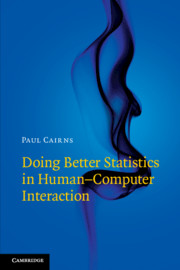Book contents
- Frontmatter
- Dedication
- Contents
- Figures
- Tables
- Acknowledgements
- Getting Started
- Part I Why We Use Statistics
- Part II How to Use Statistics
- 5 Planning Your Statistical Analysis
- 6 A Cautionary Tail: Why You Should Not Do a One-Tailed Test
- 7 Is This Normal?
- 8 Sorting Out Outliers
- 9 Power and Two Types of Error
- 10 Using Non-Parametric Tests
- 11 A Robust t-Test
- 12 The ANOVA Family and Friends
- 13 Exploring, Over-Testing and Fishing
- 14 When Is a Correlation Not a Correlation?
- 15 What Makes a Good Likert Item?
- 16 The Meaning of Factors
- 17 Unreliable Reliability: The Problem of Cronbach’s Alpha
- 18 Tests for Questionnaires
- Index
5 - Planning Your Statistical Analysis
from Part II - How to Use Statistics
Published online by Cambridge University Press: 26 January 2019
- Frontmatter
- Dedication
- Contents
- Figures
- Tables
- Acknowledgements
- Getting Started
- Part I Why We Use Statistics
- Part II How to Use Statistics
- 5 Planning Your Statistical Analysis
- 6 A Cautionary Tail: Why You Should Not Do a One-Tailed Test
- 7 Is This Normal?
- 8 Sorting Out Outliers
- 9 Power and Two Types of Error
- 10 Using Non-Parametric Tests
- 11 A Robust t-Test
- 12 The ANOVA Family and Friends
- 13 Exploring, Over-Testing and Fishing
- 14 When Is a Correlation Not a Correlation?
- 15 What Makes a Good Likert Item?
- 16 The Meaning of Factors
- 17 Unreliable Reliability: The Problem of Cronbach’s Alpha
- 18 Tests for Questionnaires
- Index
Summary
A common question of researchers learning statistics is which test to use. However, this greatly depends on the research question and what experiments have been or might be done. It is not possible to give a simple answer to this question. Instead, this chapter provides three principles that can help guide researchers to devise the right experiment and to choose the right test to address their particular research question. These three principles arearticulation, simplicity and honesty.
- Type
- Chapter
- Information
- Doing Better Statistics in Human-Computer Interaction , pp. 71 - 79Publisher: Cambridge University PressPrint publication year: 2019

